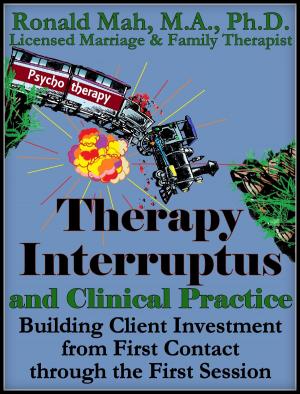Roles, Rigidity, Repair, and Renovation in Relationships and Therapy
Nonfiction, Health & Well Being, Psychology, Family Therapy, Counselling| Author: | Ronald Mah | ISBN: | 9781310490309 |
| Publisher: | Ronald Mah | Publication: | January 17, 2014 |
| Imprint: | Smashwords Edition | Language: | English |
| Author: | Ronald Mah |
| ISBN: | 9781310490309 |
| Publisher: | Ronald Mah |
| Publication: | January 17, 2014 |
| Imprint: | Smashwords Edition |
| Language: | English |
"Roles, Rigidity, Repair, and Renovation in Relationships and Therapy." Structural theory and therapy principles are applicable not merely with the family, but also applicable to the couple and other relationships, as well as for individual intrapsychic issues among various personas, the ego, id, and superego, or conflicting motivations, drives, needs, feelings versus thoughts, and so forth. Structurally oriented therapy seeks to change organizational patterns of problematic communication and potentially or actively neglectful, harmful, or abusive behaviors. The therapist is guided to take an authoritative position to alter the structure of relationships for the individual, couple, or family. More passive therapeutic approaches are revealed as counter-indicative when the individual for him or herself, or the parents form ineffective executive dyads. The therapist facilitates structural change including lessening or eliminating emotionally and psychologically harmful symptoms. The therapist works to make clients become aware of behavior, situations, roles, and how choices are made. The individual may take, be given, or be compelled to roles and responsibilities that create inherent dysfunction. Rigid and enmeshed extremes in any area can indicate dysfunctional coalitions between and among relationship, couple, or family members.
The therapist is directed to specific client compositions that indicate structural problems and are well served by structural therapeutic principles: blended families, step-parents, families in transition, culturally different couples including same sex couples, and so forth. Also certain client issues benefit from structural assessment and strategies: abuse of any type, substance abuse, and addictions. The therapist will learn important relationships and distinctions between equality and equity-based partnerships including culturally-based models that challenge mutually reciprocal intimates. Structural issues from various influences, including rigid versus over-diffuse boundaries may require repair. The therapist is directed to facilitate reparative processes for addressing problematic or broken dynamics, including poor communication and abusive or neglectful behavior. Therapy is guided to accentuate the good and effective, further facilitating healthy recovery and growth. Ineffective or harmful structure and boundaries are minimized and if possible, eliminated. The therapist is prompted to recognize how sometimes, the relationship structure or boundaries may be inherently corrupt if earlier models were never that healthy. Since sometimes old boundaries had never led to mutually healthy reciprocal nurturance and support in the past or the present, beyond repair the system requires therapeutic attention for a major overhaul or complete renovation to achieve functionality.
"Roles, Rigidity, Repair, and Renovation in Relationships and Therapy." Structural theory and therapy principles are applicable not merely with the family, but also applicable to the couple and other relationships, as well as for individual intrapsychic issues among various personas, the ego, id, and superego, or conflicting motivations, drives, needs, feelings versus thoughts, and so forth. Structurally oriented therapy seeks to change organizational patterns of problematic communication and potentially or actively neglectful, harmful, or abusive behaviors. The therapist is guided to take an authoritative position to alter the structure of relationships for the individual, couple, or family. More passive therapeutic approaches are revealed as counter-indicative when the individual for him or herself, or the parents form ineffective executive dyads. The therapist facilitates structural change including lessening or eliminating emotionally and psychologically harmful symptoms. The therapist works to make clients become aware of behavior, situations, roles, and how choices are made. The individual may take, be given, or be compelled to roles and responsibilities that create inherent dysfunction. Rigid and enmeshed extremes in any area can indicate dysfunctional coalitions between and among relationship, couple, or family members.
The therapist is directed to specific client compositions that indicate structural problems and are well served by structural therapeutic principles: blended families, step-parents, families in transition, culturally different couples including same sex couples, and so forth. Also certain client issues benefit from structural assessment and strategies: abuse of any type, substance abuse, and addictions. The therapist will learn important relationships and distinctions between equality and equity-based partnerships including culturally-based models that challenge mutually reciprocal intimates. Structural issues from various influences, including rigid versus over-diffuse boundaries may require repair. The therapist is directed to facilitate reparative processes for addressing problematic or broken dynamics, including poor communication and abusive or neglectful behavior. Therapy is guided to accentuate the good and effective, further facilitating healthy recovery and growth. Ineffective or harmful structure and boundaries are minimized and if possible, eliminated. The therapist is prompted to recognize how sometimes, the relationship structure or boundaries may be inherently corrupt if earlier models were never that healthy. Since sometimes old boundaries had never led to mutually healthy reciprocal nurturance and support in the past or the present, beyond repair the system requires therapeutic attention for a major overhaul or complete renovation to achieve functionality.















